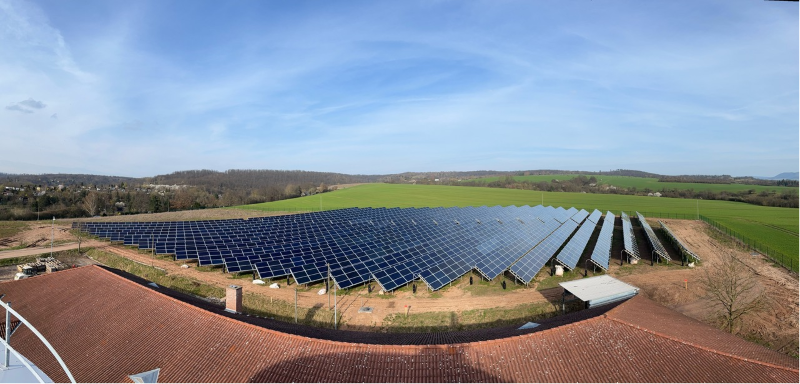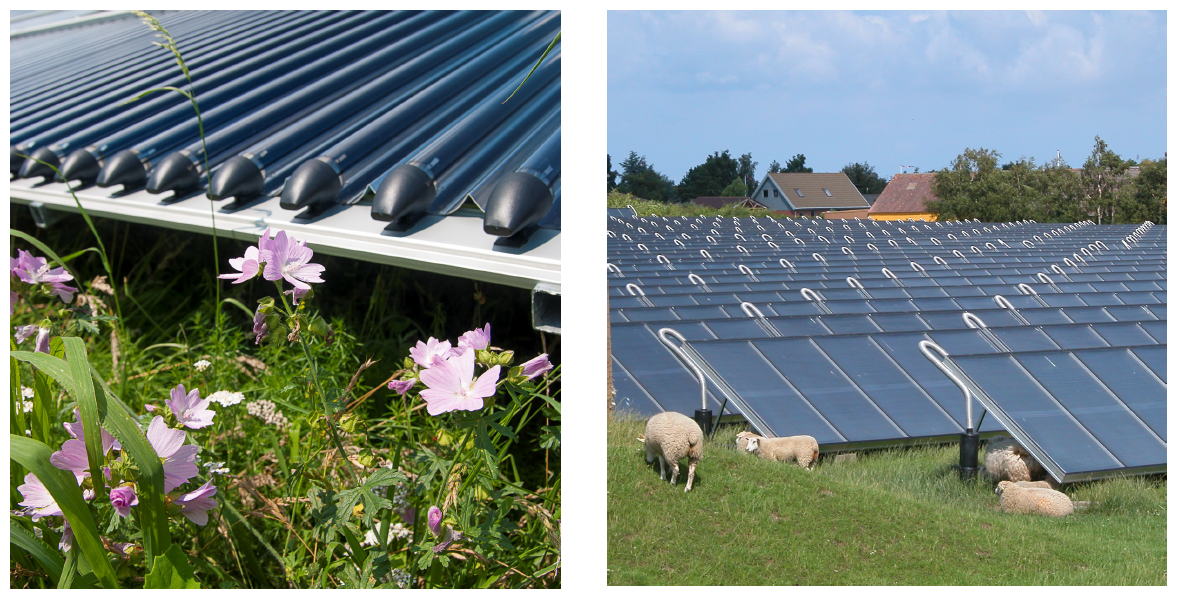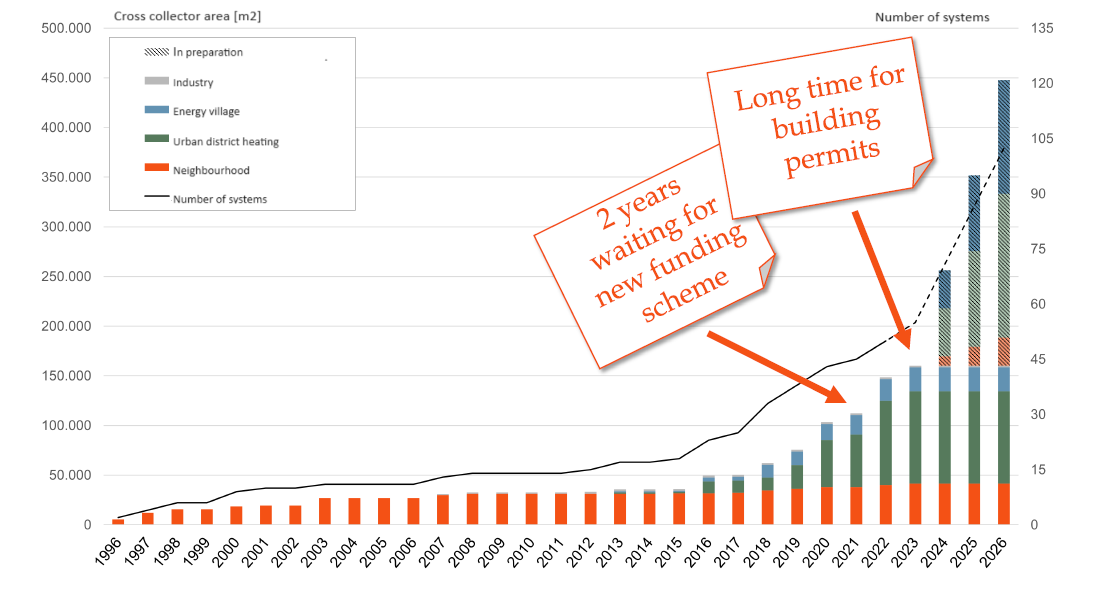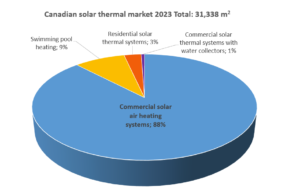

“District heating has never had such a high significance in Germany”
In Germany, one record-breaking plant is being built after another. Solar district heating is a large, rapidly growing business. This could be an inspiring model for the UK, said George Bennett, British representative on the Exco of the IEA Solar Heating and Cooling Programme. He used the IEA SHC Solar Academy webinar series to offer a specially designed event under the title “Making low-carbon district heat a reality in the UK”. Two German solar district heating (SDH) experts reported on the success factors and policies. Magdalena Berberich, Vice Executive Director at the research institute Solites, and Thomas Pauschinger, International R&D Responsible at the German district heating association AGFW. The recording and the presentations are available online. The photo shows a new 4.7 MW solar field in central Germany with evacuated flat plate collectors that provide heat at between 80 and 95 °C to the district heating grid.
Photo: TVP
“This webinar is designed to bring together two excellent technologies – solar heat and district heating. We want to collect experience from abroad and see how we can use it in the UK”, explained George Bennett, talking about the objectives of the event. He is the British representative in the IEA Solar Heating and Cooling Programme and was co-moderator of the webinar.
In fact, the two German experts complemented each other well and comprehensively described the successes and challenges in the German SDH market.
Pauschinger confirmed that district heating has never had such a high significance in Germany: “The government is really focusing on the heat sector with a series of policies. In the transition of the heating sector there are two pillar technologies – district heating as the centralized solution and heat pumps as the decentralized solution”. He praised the district heating summit of 2023 which “will bring speed to the transformation and extension of the district heating sector”. In this public-private dialogue a few important goals were set:
- Tripling the number of buildings connected to DHC by 2045
- Connection of at least 100,000 buildings per year to heating networks in the medium term
- Average share of 50 % renewables and unavoidable waste heat in DHC networks by 2030
Germany currently has 4,100 district heating systems with 34,000 km of pipeline supplying 140 TWh and covering 14 % of the heat demand in the buildings sector. At present, 30 % of this heat is already climate-neutral if waste heat and waste incineration are included in addition to renewable energy sources.

New policies relevant for district heating in Germany since the current government agreed on its coalition contract in 2020. Source: AGFW
“Obtaining funding for each individual project at the local level is a challenge”
Berberich expects the German solar district heating market to triple in size over the next few years. There are currently 55 solar district heating plants with a total of 112 MW in operation (as of January 2024). Nine further systems with 79 MW are in the realization phase and 70 plants with 277 MW are in preparation.
This long-term growth path is flanked by a series of supportive laws (see graphic above). A decisive one is the Local Heat Planning Law that came into force at the beginning of 2024. It implements the requirements of the Energy Efficiency Directive of the European Commission. The law stipulates that all of the approximately 11,000 municipalities have to make suggestions for areas where district heating is being expanded and where individual houses should be refurbished. In large cities with more than 100,000 inhabitants the plan should be available by 30 June 2026. In municipalities with less than 100,000 inhabitants by 30 June 2028. Smaller municipalities with less than 10,000 inhabitants can undertake a simplified heat planning procedure.
The Local Heat Planning Law also sets national targets for the decarbonization of heating networks. From 1 January 2024, at least 65 % renewable heat must be fed into every new heating network. By 2030, half of district heat is to be generated in a climate-neutral way.
“So the political conditions are generally positive,” summarized Pauschinger. But on the other hand he emphasized the fact that enormous investments are necessary and obtaining funding for each individual project at the local level is a challenge.
Solar district heating is on the growth path, but with some barriers that have delayed expansion in recent years Source: Solites
Efficient heat networks: Funding attracted 1,300 applications and EUR 677 million have been approved
According to Pauschinger the BEW funding scheme that started in September 2022 was a game changer. BEW is short for Federal Funding for Efficient Heating Networks. EUR 4 billion are available until 2026. Pauschinger praises the holistic approach of the funding scheme, which finances the long-term transition plants and individual renovation measures but also the change in heat production capacities to renewables and extension of existing district heating networks. The heating sector fully utilized the potential of the large funding budget. In the first one and a half years more than 1,300 applications have been made and funding of roundabout EUR 677 million has been approved.
BEW grants subsidies with up to 40 % of the investment costs plus an operation subsidy for solar district heating systems as well as other renewable technologies. Consequently, economic viability of SDH systems looks good, as both speakers confirmed. Large solar thermal fields offer stable heat costs of between 40 and 70 EUR/MWh over the lifetime of the system before funding and withoug seasonal storage, stated Berberich. Together with the BEW funding this is cost effective in most cases against the long-term costs of heat produced by gas fired boilers.

Biodiversity below large solar collector fields either with flowering meadow or as sheep runs Photo: Guido Broer / Erik Christensen
Structured analysis of all possible areas necessary
Together, the two solar district heating experts listed some barriers that still need to be removed in Germany. “Finding areas near the heat demand is a big task in project development”, said Berberich. What is important here is close communication between the utility companies, investors and the local authorities and a structured analysis of all possible areas.
With a higher share of renewable heat, heat providers will focus more on security of supply, which is difficult to achieve with a variable heat source like the sun, said Pauschinger, pointing out another obstacle. Seasonal storage is a possible solution here. Such storage systems are proven and mature for smaller networks. However, for really large networks storages with more than 1 million m3 are needed for which additional R&D activities are still necessary.
Pauschinger also stated that many district heating grids in Germany are still operated at high supply temperatures above 100 °C: “Substantial lowering of temperatures is a complex, costly and long-term process,” he said.
Berberich emphasized that there are collector types that can supply heat with temperatures above 100 °C, which are further analysed within the IEA SHC Task 68 on Efficient Solar District Heating. In the coming months you will find the report “Comparison of different collector technologies especially considering medium-high temperature heat and best practice examples” on the IEA SHC Task 68 Website.
Websites of organizations mentioned in this news article:
IEA SHC: https://www.iea-shc.org/
IEA SHC Task 68: https://task68.iea-shc.org/
Webinar “Making Low Carbon District Heat a Reality in the UK”: https://www.iea-shc.org/solar-academy/webinar/making-low-carbon-district-heat-a-reality-in-the-uk
Solites: https://www.solites.de/en/
AGFW : https://www.agfw.de/



